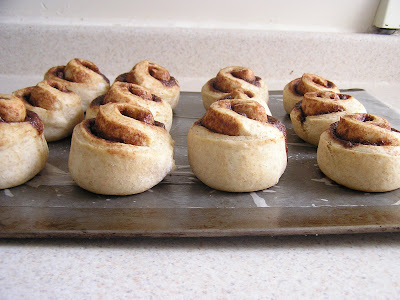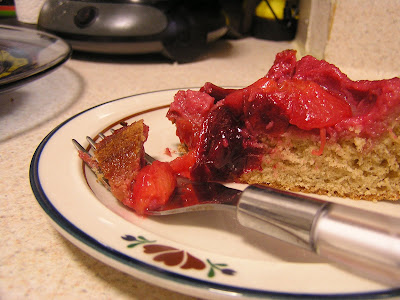Normally, every year for Christmas Eve we drive down to
Northfield, MN where we spend a lovely evening with my Dad's family. This year, however, it snowed. And snowed. And snowed. So we stayed home. This was my first Christmas Eve not spent in the presence of a room full of relatives, and while I was somewhat relived to put off the perpetual "So what are your plans for next year?"
conversation, they are my family, and being stuck at home with no plans for holiday cheer, I wanted to do something special. So I orchestrated a nice Scandinavian dinner. Meatballs with mashed potatoes, gravy,
lingonberry jam, and peas, while perhaps a very
stereotypical Swedish meal (in fact because of the last minuteness of it all, the meatballs were frozen
köttbullar from
IKEA that we always seem to have on hand) it is a meal that I have seen some variation of in just about every Swedish restaurant I've ever been to. And who could blame them, the sweet and savory mixture of gravy and
lingonberry complements the meat so nicely.
My Dad made the mashed potatoes, peas, and gravy. I got the honor of microwaving meatballs while my mom fixed salad, but where I really decided to make home feel like
Christmas was with dessert: rice pudding and
glögg. Rice pudding (
risgrynsgröt) is super simple to make. For one cup of rice (
preferably a stickier rice than the jasmine rice we had on hand) use one quart of whole milk and a little bit of salt. I made do with a quart of 1% and maybe a third of a cup of cream, and have also been told to use a small can of evaporated milk and the rest 1% (or skim or 2%) to fill out the quart. Also lots of recipes I've been finding call for 2-3 quarts of milk, without specifying the fat content. This recipe is most definitely not picky. You simmer (either in a double boiler or on the lowest possible heat (if you have it heated directly, watch it, without a double boiler I almost always have it boil over on me at least once) this all for about an hour (if you're using one quart of milk, longer for more) but I never time it, I always just stir occasionally and stop when it looks like delicious rice pudding.
While you can make rice pudding year round (in fact, I practically lived off it while I had mono in Denmark, because it was the easiest cheapest way to make something that was soothing to my throat) it is also a special Christmas dessert. One Danish girl I lived with made fun of me for making rice pudding when it wasn't Christmas (but then later a Danish guy moved in who made it every other week as a meal). What makes Chrismas rice pudding special is the addition of one whole almond. It's said that whoever get's the almond in their bowl get's luck for the coming New Year.

After it's done gooking and cooled off a bit you dish it out in small bowls and sprinkle cinnamon sugar on top and put a pad of butter.

When the rice pudding was about 10 minutes away from being done, I started making the
glögg. Glögg is a traditional Swedish holiday drink, made by mixing burgundy wine and brandy (because we only had 3 people drinking it, we did 325 mL of each, however normally you would do a whole bottle of each) You simmer this (uncovered, or else it lights itself on fire when you take the lid off, as I found out!) for about five minutes with a cup of blanched whole almonds and a half a cup of dried currants (or raisins if you don't have currants) and spoonful of mulling spices (whole cloves, some candied orange peel, a cinnamon stick, etc.) plus 10 or so cardamom seeds (not normally included in mulling spice mixes).

Next comes the fun part. Get a second pot or serving container, and put a strainer over it. Put up to a half a pound of sugar cubes in the strainer (for the full recipe, 1/4 lb. for the half recipe). Light the whole thing on fire, and pour it slowly over the sugar cubes. Serve and enjoy! If it doesn't burn for very long the whole thing comes out pretty potent, and goes down nice and warm.

Merry Christmas -
God Jul I've had yeast trouble in the past, so this time I made sure to proof the dough. All was well and rising went prefectly.
I've had yeast trouble in the past, so this time I made sure to proof the dough. All was well and rising went prefectly. It took three different batches (one with a different recipe, and one with a typo in the translation, and the one linked to above, typo free) before I came out with this result. And while I think I may have waited too long, and can't, for the life of me, tell whether this recipe is even close to what I had in Denmark, it is absolutely wonderful. One think I know is different though, is that the cardomom is much more noticable in these buns than how I remembered. For a more subtle bun I woould try halving the amount of cardamom.
It took three different batches (one with a different recipe, and one with a typo in the translation, and the one linked to above, typo free) before I came out with this result. And while I think I may have waited too long, and can't, for the life of me, tell whether this recipe is even close to what I had in Denmark, it is absolutely wonderful. One think I know is different though, is that the cardomom is much more noticable in these buns than how I remembered. For a more subtle bun I woould try halving the amount of cardamom.




















































